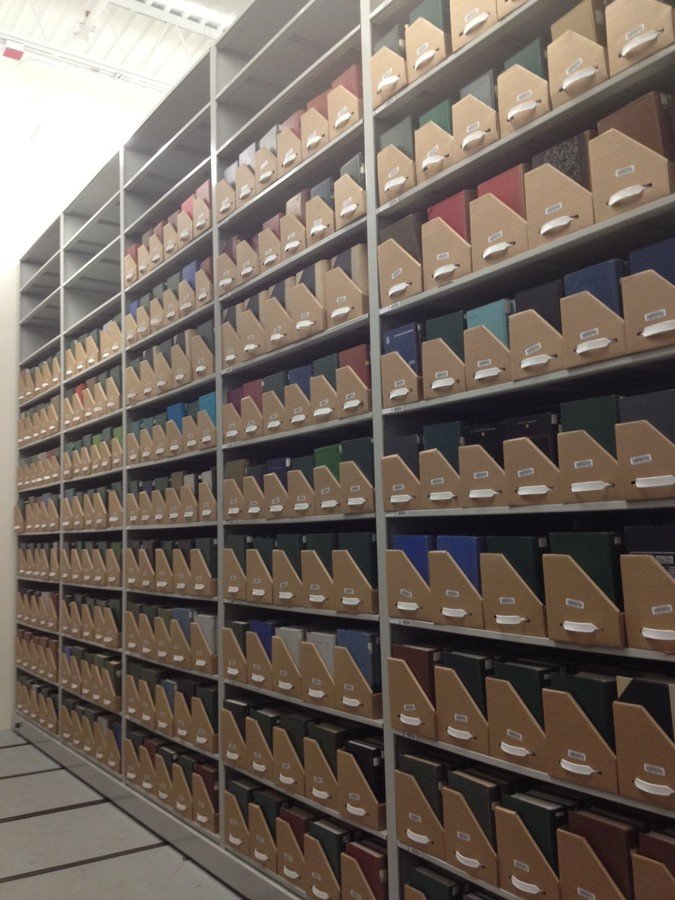ShelfLoc
Managing high-density storage of library materials
Eric Bivona and Joe Montibello
Dartmouth College
Storage Library
- Items were stored in bays, with some
effort to collocate by call number
- Shelf location information manually
entered and tracked in item records
- Building was basically full in 2012
- Had been occupied for approximately 5 years longer than was originally planned
- Physical condition of the building was deteriorating

Dana Library
- Scheduled for demolition in 2013
- Collection of ~80,000 items
- New library construction would take 2+ years
- Collection would need offsite storage during demolition and construction

A new hope!
- Library secured storage space in another facility nearby
- Conceived as high-density storage: compact shelves, items shelved by size
- Our ILS is built around locating things by location code and call number - not adaptable to high-density storage needs

Vendor Solution
- The leading bid was from a vendor that we already had doing work for us
- Would require our care and feeding but would not be in our control
- The resulting system would not have integrated with our ILS
- Capital outlay
Local solution
- We could build a system using Perl and the campus Oracle database
- We would own the code and be able to modify it as needed
- We could achieve better integration with the ILS
- Cost limited to staff time
Software possibilities
We got approval from library administration to go forward with the local solution.
Conceptual model:
- Hierarchy:
Facility > Floor > Room > Stack > Section > Shelf > Tray > Item - Place barcodes on every item, tray, and shelf in the facility
- Put items of like size in trays together
- Put trays of like size on shelves together - minimize wasted space
- Represent the location hierarchy in the database so that a walkable order can be output
- Build a web interface for ingest
- *Build out capabilities for reporting, deaccessioning, and other storage maintenance tasks
Valid locations

Ingest Process
- Items are sized, A-E, by laying them on a template
- Items are sorted into appropriate trays based on size
- When a tray is full, the tray's barcode and all item barcodes are scanned, building the item to tray associations
- The tray is then re-scanned to verify that the initial scan caught all items in the correct order
- Trays then get shelved, and scanned along with the shelves they sit on, associating multiple trays to a shelf
- Shelf location is written into the item record in the ILS
The book movers who came and did the ingest were pleased with the system, and told us that it was easier to use than the commercial systems they were used to using.

In practice:
- We ingested 80,000 items for the Dana Library in a little over a month
- A year and a half later, we closed the existing Storage Library
- At that point we opened a second room in the Depository and ingested nearly 400,000 more items
- We have continued to add functionality to the software - deaccessioning, shelf utilization graph, additional reporting

Syncronization with ILS
Examining ShelfLoc for purgable III metadata.
Processed 81254 records for location "DXNA" with 0 errors.
[...]
Processed 4382 records for location "bxkrh" with 3239 errors:
3151 micro-form records lack a barcode (950|z).
88 records lacked a barcode (950|z):
b2402873a/i2864520a/#415696
[...]
Total counts:
478711 records read from III.
3290 records rejected.
1 record updated.
475420 records unchanged.
49 records updated in III (950|s).
2 ingested, on reserve items.
Paging slip enhancement

- Emailed to a program
- Shelf location field added (because the ILS wouldn't do it)
- Scannable barcode generated and printed
Visualization of space


Results:
√ Items shelved by size
√ Shelf location tracked in ILS
√ Builds upon existing requesting / paging processes
√ Development continues as needed
